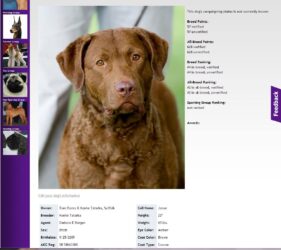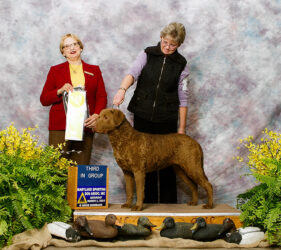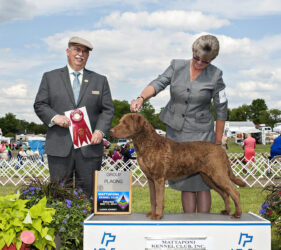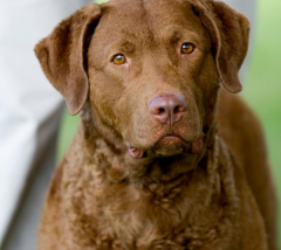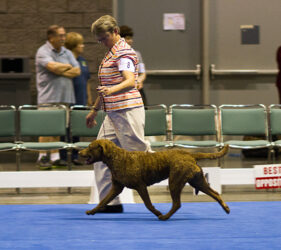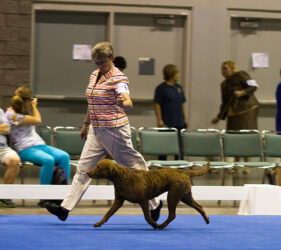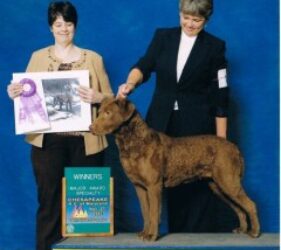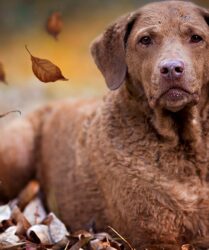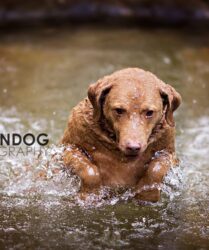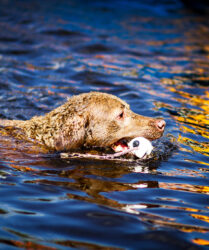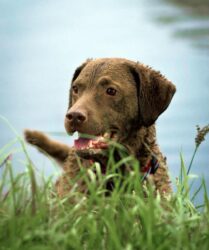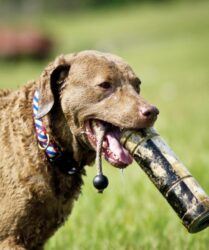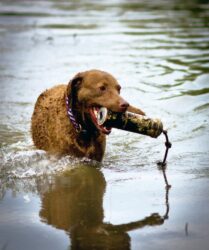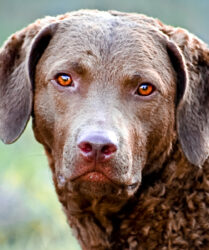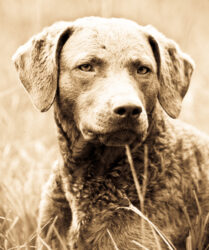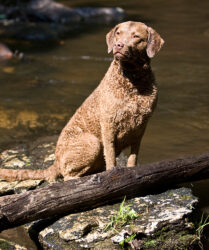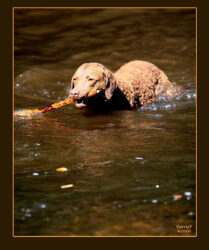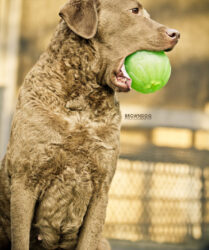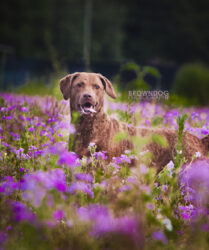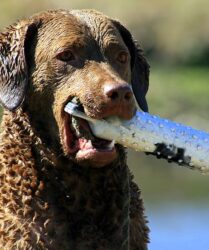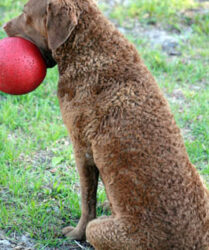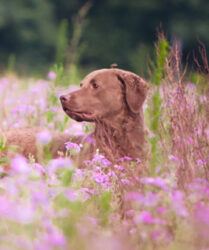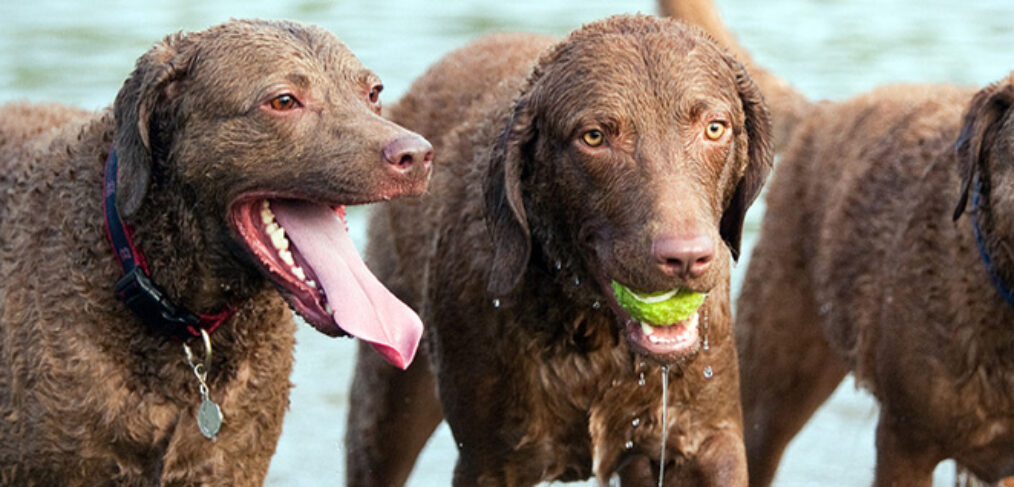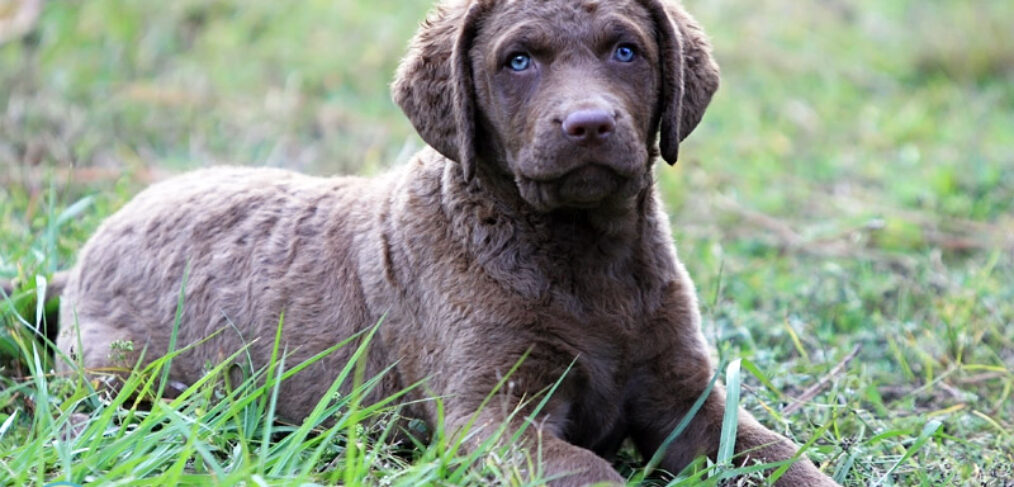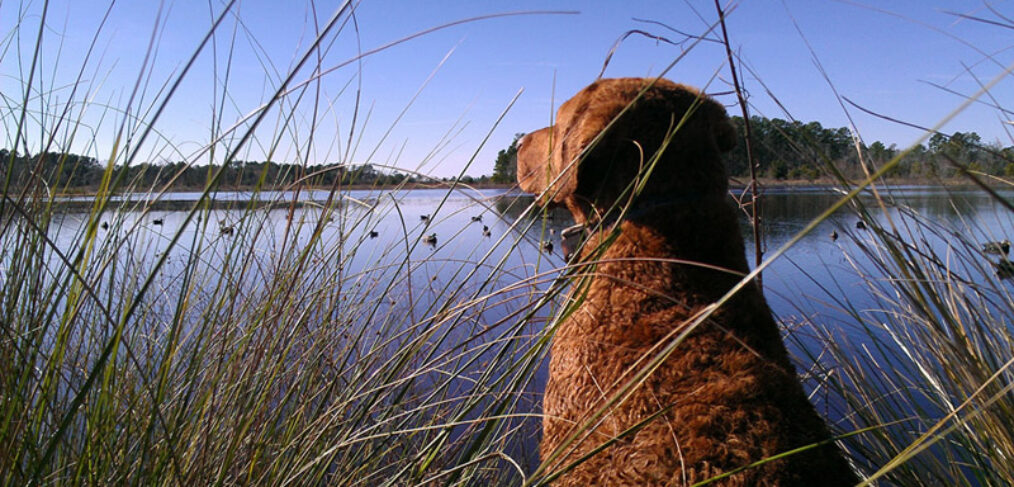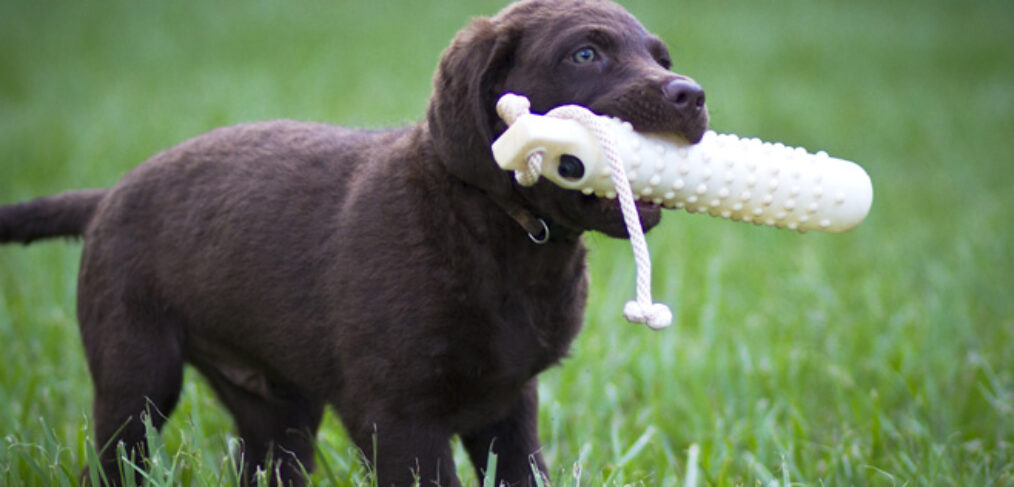Jesse has many positive attributes about her – including little ears, lovely length of neck, beautiful shoulders, short in loin, ample substance and a gorgeous head and expression. Her movement, too, is very correct and sound – clean coming and going with good reach and drive.
With very limited showing, Jesse earned her AKC show championship with one 4-point major earned at a Regional Chesapeake Show Specialty and TWO 5-point majors earned during an American Chesapeake Club Supported weekend. All shows had good competition with 20 or more Chesapeakes entered. Also, in September 2011, the same weekend she turned 2 years of age, Jesse took the Select Bitch award at the Chesapeake National Show Specialty. This was one of the largest specialty’s in breed history – with over 400 Chesapeakes entered. Like her Championship, Jesse went on and earned her Grand Championship very quickly and in 2013, Jesse took the Best Opposite Sex win at the AKC/Eukanuba show.
Temperament wise, Jesse has a very happy-go-lucky go-with-the-flow attitude. Like many Chesapeakes, she bonds strongly to those she knows. She gets along well with other dogs – both male and female. We are very excited about Jesse’s future and more information on her will be forthcoming.
Jesse is handled exclusively by Darlene Bergan.
Elbows: Normal
PRA: A by Parentage
CERF: Normal
| CH** Misty Hill Nash | CH Prince Hannibal of Jala | CH**/CanCH Chesacola’s Brutus Beefcake CD |
| Haute Southern Bell of Jala | ||
| CH Ches-Shores Misty Hill Genesis | CH Chestnut Hills Marketeer | |
| CH* Ches-Shores Princess Tala | ||
CH Silvercreek’s Spiced Rum |
Cabinridge’s Crack Me A Bud |
CH Chesabar’s Mt’n Bruiser CD JH WDX |
| CH Cabinridges Favorite Fergie | ||
BISS GCH**/CAN CH Silvercreek Casbar’s Cheers |
CH*/Can BIS CH** Silvercreek Remington Steele JH WD |
|
Mattamuskeet’s Diamond Maggie G |

CH Silvercreek’s Spiced Rum
Morgan is the matriarch here at 11 1/2 years of age. She’s a medium brown in color and right in the middle of the Chesapeake standard at about 23″ to the shoulder and 65-70 lbs. She’s a nice size and isn’t overly done in any respect. She has a fabulous harsh coat that is very brillo like in feel and like her mother, she has fabulous movement which appears effortless. Morgan’s handlers often comment on how wonderful she is to show as she simply glides around the ring.
Morgan is very easy to live with. Like most Chesapeakes, Morgan is a wonderful marker and has great drive with a strong desire to retrieve and swim. She will often nudge you to throw a ball or bumper for her just one more time — she’d go all day long if you’d let her. She gets along well with other dogs but can be a little reserved with people she doesn’t know.
In 2007, Morgan took 2nd place in the Open Bitch class at the Chessie National Show Specialty in Colorado Springs, CO. In February 2008, she obtained her Champion title under judge Mr. Richard L. Bauer. In the end, she took Best of Breed over multiple male specials earning herself a 5 point major.
We often call Morgan “Wiggle, Wiggle” because when she’s happy her whole body just wiggles with excitement.
OFA- Good: CB-8914G26F-VPI
Cardiac – Normal: CB-CA58/26F/P-VPI
Elbow – Normal: CB-EL1284F26-VPI
Thyroid – Normal: CB-TH66/26F-VPI
PRA: A
DM: N/N – Clear/Normal
|
Cabinridge’s Crack Me A Bud |
|
| CH Chesabar’s Mt N Bruiser CD, JH | CH Chesbar’s Star of Obadiahs |
| CH Chesabar’s Brittany | |
| CH Cabinridge’s Favorite Fergie | CH CHes-Shores Crazy As A Loon |
| CH Cabinridge’s Glowing Amber | |
|
BISS Am/Can CH*Silvercreek Casbar’s Cheers |
|
| BIS Am/Can CH* Silvercreek Remington Steele JH, WD | CH Pond Hollow Calico Key Largo |
| Am/Can/PR/World CH* Silvercreek I Love Lucy JH, WD, CGC/TDI ROMQ | |
| Mattamuskeet’s Diamond Maggie G | CH Sand Bar’s Cast In Stone |
| CH Mattamuskeet Lady of the Lake |
The Chesapeake coat is double coated—that is, it has both a soft wooly undercoat and a coarser topcoat (outer coat).
Shedding
Many people ask me “Do Chesapeakes shed?” Yes, Chesapeakes shed and some shed a lot. If you’re looking for the next non-shedding, low maintenance dog then a Chesapeake is not for you.
Most Chesapeakes shed their undercoat twice a year and regrow it again as colder weather comes in; this is also referred to as blowing coat. In many climates, the topcoat and undercoat might shed continuously in greater and smaller quantities all year.
The pattern in which a Chesapeake may shed its coat will vary from dog to dog. Some, will shed minimally but continuously; others, will shed in patches while others will go nearly bald all over.
To help the shedding process you can:
1. Give the dog warm baths to help remove the undercoat
2. Brush (I do this outside) with a Zoom Groom type brush
If your dog’s hair does not start growing back after a month or two, then the shedding might be caused by nutrition or some underlying medical issue. Nutrition plays a big part in coat and each dog is different. For example, my oldest girl goes nearly bald (sheds much more) when she eats ProPlan dog food. However, my youngest does very well on it. A common medical issue in Chessies, thyroidism, can also cause hairloss.
Colors
There are three basic colors in the breed Brown, Sedge and Deadgrass. Brown, is from a very light, silvered brown to a rich deep dark bittersweet chocolate. Sedge is from a reddish yellow through varying chestnut shades to a bright red. Deadgrass varies from faded tan to a dull straw color. The difference between Sedge and Deadgrass is that Deadgrass contain no significant amount of red, while Sedge does.
Some Chesapeakes have varying degrees of other markings such as: masking on topskull, brindling (a striping effect of light & dark through the body and on the legs), distinct & indistinct saddle markings, agouti coloring and tan points. All are acceptable, but are not preferred, and should not be disqualified in the conformation ring.
There are two color disqualifications in the breed: black coloring and white on any part of the body except breast, belly, toes or back of feet. White which extends above the point of the sternum, whether connected or unconnected to white below, is a disqualifying location. Premature graying does occur in Chesapeakes and should not be cause for disqualification. White is also allowed on the toes and on the back of the feet. Legal white can also occur on the sheath of the penis. The preputial region is a subregion of the pubic portion of the abdomen, in common terms belly.
Chesapeake puppies tummies can be sensitive to food changes so we suggest you keep your pup on the same food. If you decide to change his/her food it needs to be done very gradually.
Set a feeding schedule…
We highly suggest setting a feeding schedule for your puppy — and keeping to it — which will aide in housebreaking.Your Chessie puppy has been eating three times a day at approximately 6:30 a.m. (breakfast), 12:00 p.m. (lunch), and 6:00 p.m. (dinner). This schedule is not cast in stone and can fluctuate slightly. However, we recommend the final feeding be no later that 7:00 p.m. This will allow enough time for the puppy to go outside a few times before bedtime.
Your puppy’s breakfast should be given after he/she has gone potty outside and had a little play session. Lunch should be given approximately halfway between the breakfast and dinner feedings. At first, give your puppy about 3/4 cup of food. Let the pup have access to the food for about 15 minutes. If there is any food left in the bowl after 15 minutes, then pick up what hasn’t been eaten. Do not give him/her more food until the next feeding time. At that time, give the puppy its normal allotted food amount. Continue this through his/her scheduled feedings
As Chessie puppies grow, so do their appetites. If your puppy consistently finishes all of the food offered, and he/she isn’t overweight, then you can increase the amount foodd, 1/4 cup at a time. Many Chessie puppies eat a lot, and will act famished even if they aren’t. Be careful not to overfeed. It is important that your puppy not become overweight. You should be able to feel the ribs quite readily when your pup is standing.
We do NOT recommend free feeding your Chessie.
Three feedings to two …
By six months of age, we recommend a twice a day feeding schedule. At this time take the same amount of food you have been feeding in a day and divide it into two feedings. At one year you may switch to feeding once a day.
Switching foods …
Typically, adult female Chessies eat between 1 and 3 cups per day, while males eat between 3 and 5 cups per day. Food consumption varies from dog to dog based on individual metabolism and activity level. It is not recommended to feed the amount on the packaging – instead, feed according to your dogs needs. If your dog looks a little plump, then cut him/her back 1/4 cup. If your pup looks thin, then increase his/her food.
If you feel you need to switch foods. Please do so gradually to help avoid stomach upset. Below is a general guideline on how to switch foods:
Day 1 & 2: feed 3/4 old food and 1/4 new food (mixed together)
Day 3 & 4: feed 1/2 old food and 1/2 new food (mixed together)
Day 5 & 6: feed 3/4 new food and 1/4 old food (mixed together)
Day 7: feed 100% new food
Thank you for your interest in one of our puppies.
Socialization and early training are essential for Chessie puppies to develop into confident well-rounded adults. In our home, puppies are handled daily and are exposed to a variety of different items and environments as they grow including, but not limited too, other dogs & people, water, birds and gun shot when appropriate.

CoolWaters Night Sky – “Skylar”
Litters are bred with the primary goal of keeping something for ourselves. As such, we are very selective about what we breed and we have very few litters. Due to this, we reserve the right to evaluate and pick our choice(s) from the litter regardless of sex or color before any pet puppy picks are made. These evaulations are usually done at seven or eight weeks of age. Unless other arrangements have been made, all pet puppies are sold on AKC Limited Registration which means the puppy cannot be bred or shown in conformation events but may participate in obedience, agility, hunt tests or any other performance event.
All CoolWater puppies are examined by a licensed Florida veterinarian and sold with a current Florida State health certificate. Per Florida law, puppies do not go to their new homes until 8 weeks of age. They are wormed at 4, 6, and 8 weeks and vaccinated according to the American Animal Hospital Association (AAHA). They have dew claws removed, are microchipped and have their first series of shots. Please note that according to the AAHA’s vaccination protocol many vaccinations can be given every three (3) years instead of annually. We strongly suggest you share AAHA’s Canine Vaccine Guidelines with your veterinarian to discuss a protocol that will work for you and your pet.
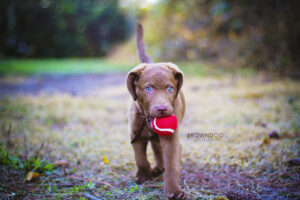
CoolWaters Perfect Storm – “Surge”
Each puppy will go home with a packet that includes record of vaccinations and wormings, feeding instructions, follow-up care instructions, a copy of all contracts & guarantees, pictures and clearances of parents and other Chessie related material. All puppies are registered with the CoolWater prefix and formal names will be submitted by us. However, we are open to any ideas or suggestions you may have.
We understand that certain circumstances may happen where you are no longer able to provide a home for your CoolWater Chesapeake. We ask that you contact us immediately and offer us first right of refusal. Your CoolWater Chessie should never end up in a shelter or be homeless.
We welcome all inquiries and are happy to hear from and talk to you about this wonderful breed!
Chesapeake Bay Retrievers have an interesting background and many stories have been written about the breed. Here, you will find a small collection of articles and stories that I have found. Please take a moment and read through them.
If you are wondering whether a Chesapeake Bay Retriever is right for you, I recommend reading these two articles first: Don’t Buy a Chessie and Chessies Aren’t For Everyone. If, after reading these two articles, you are still wondering if a Chessie is right for you, feel free to contact me: coolwaterchesapeakes@gmail.com. I’m happy to discuss the breed with you and help you make an informed decision for you and your family.
- Don’t Buy a Chessie
- Chessies Aren’t For Everyone
- Where have all the Chessies gone?
- The Chesapeake Bay Retriever Vivacious & Versatile
- Field & Stream Magazine Article
- A Charmed Life
- The Chesapeake Bay Retriever by M.J. Nelson
- The Chesapeake Bay Retriever by Gary Koehler
- Raising Kayla
- The All-American Chessie
Below, is a list of books and stories written about the breed. If you know of others that should be added to the list, please let me know.
Title: Author
- The Complete Chesapeake Bay Retriever: Eloise Heller Cherry
- Batfishing in the Rainforest: Randy Wayne White
- Dara: Autobiography of a Chesapeake Bay Retriever: Lolo Sarnoff
- Life with Grover A Cheapeake Bay Retriever: Alexander Crosby Brown
- Iron Men and their Dogs: Ferdinand C. Latrobe
- The New Complete Chesapeake Bay Retriever: Dr. Daniel Horn & Janet Horn
- Chesapeake Bay Retriever Champions, 1988 – 2000: Jan Linzy
- Chesapeake Bay Retariever Champions, 2001 – 2005: Jan Linzy
- A History of the Chesapeake Bay Retriever: Eloise Heller (1967 – a rare find)
What is PRA?
Below are extracted pieces of the article, Breeders Ask Optigen… The Whys and Wherefores of Testing Your Dog for PRA by Mary M. Woodsen. For the purpose of this Web site, it has been condensed and updated for Chesapeake Bay Retrievers.
Chesapeake Bay Retrievers gained access to the first genetic test in 1998. The test is by OptiGen and it detects prcd-PRA (Progressive Retinal Atrophy) in CBRs. The test is now in its third rendition.
What is PRA? Is there any way to treat it? Can I prevent it?
Progressive Retinal Atrophy (PRA–and specifically, the prcd form of PRA) is an inherited eye disease that affects not only Chesapeake Bay Retrievers but several other breeds as well. Dogs with prcd-PRA, over time, go blind.
In most breeds PRA is evident by the time a dog is at least six years old, after it has already been bred. In order to develop PRA, a dog must inherit two copies of the defective prcd-PRA gene: one from its dam, one from its sire. There’s no cure, no treatment; no way to stop it.PRA, however, can be prevented in the next generation even though you can’t treat it in the current generation. Through safe, selective breeding based on a simple DNA test.
Marker-based genetic testing.
There are two general types of marker tests used in genetic testing, and sometimes they’re confused. Our’s is a marker (linkage) test with No Chance of Recombination. This means that the marker is close enough to the gene that its chance of splitting away from that gene during meiosis (sexual reproduction) and skewing the test is less than one in several billion! (Some types of marker [linkage] tests do allow for recombination, which means that the test can give either false positive or false negative results. In other words, a small percentage of dogs that test as genetic normals could actually be a carrier or affected, and visa versa.)
This test, in fact, designates a dog as genetically normal (clear) with absolute, unequivocal, totally reliable, 100%-no-ifs-ands-or-buts accuracy. And that’s good news, because you can take your otherwise really great dog that happens to test as (probable) carrier or (probable) affected and breed it to a certified (no ifs ands or buts) normal–and know that no pup will ever be affected.
What does “probable” carrier and “probable” affected mean?
The problem with markers is this: way back when the first pup was born with a mutated gene, the gene’s marker didn’t mutate too. Indeed, that pup was the very first carrier. Of course, it still had its parents’ other healthy gene, and passed one or the other of the pair along to each of its pups. Today, dogs testing as carriers and affecteds either carry that ancestral pup’s damaged gene-plus-marker–or they carry that pup’s parent’s normal gene-plus-marker. But which gene, which marker? We can’t tell–we haven’t found the gene yet, and the markers look just alike. We call this look-alike marker a false allele.
This ancestral, normal gene-plus-marker–the false allele–is the wild card. Thus a dog may test as Pattern B (probable carrier) yet carry two normal genes, one of which has those look-alike markers. Likewise a probable affected–a Pattern C dog–may carry one damaged and one normal gene–or less likely, two normal genes. That’s why we use the designations “Pattern B” and “Pattern C”: because some Bs aren’t carriers and some Cs aren’t affected.
The marker for Pattern A has never accompanied a mutated gene and thus could never have a false allele.
Explain, please, what an allele is.
Alleles (say it a-lee-el) are different versions of the same gene. Does your sister have brown eyes, your brother hazel eyes, but yours are blue? In humans, eye color is caused by different alleles of the “eye-color gene.” (Eye color is a bit more complex in dogs.) In the same way, genes for retinal functioning have different forms, or alleles, and the defective gene is one. In fact, even markers have alleles. One of those alleles always accompanies the mutated gene, but in its ancestral form, it sometimes accompanies the normal gene.
How can you offer a test if it isn’t accurate?
Our definition of “accuracy” has to do with the detection of the markers used in the laboratory. The OptiGen test for the markers of PRA is exactly accurate. This means that the test gives clear readings in the laboratory; there is no issue of interpreting what we see–no false positive. (A false allele result is not a false positive result.) Numerous controls–absolute measures of accuracy–are used for every sample we process. The results for every dog will never change with age and will be the same whenever this current test is repeated. (In contrast, a false positive reading can change.) Pattern A dogs will always test as Pattern A. Likewise, Bs will always be Bs and Cs will always be Cs. These are lifetime guarantees–and they are accurate. As scientists we are necessarily bound to this definition of accuracy, and could not state it differently.
So a C dog can be normal, clear?
Yes, that’s possible, if it has two false alleles–two look-alike markers. Then sure, it’s actually normal, but this genetic test can’t prove it normal. It may indeed be normal but the best you dare guess, if you have a normal ERG and the dog is over six years old, is that it’s a carrier. You still need to breed it with caution to certified clears. Don’t worry – within a couple generations you can breed completely clear progeny.
Given that a dog comes back as a B or a C, what is the next best course to follow to determine its true genetic status? Should we test its parents, or perhaps its offspring or grandchildren? How do we find out if the dog really has a false allele and what do we do about it?
The markers to the prcd gene are inherited, just as is the prcd gene itself. If the look-alike false allele is involved in one dog, it will be passed from one generation to the next. Which means that testing parents, offspring or grandpups won’t help you figure out that a false allele is involved. If a dog is Pattern C (probable affected) and is bred to an A (no ifs ands or buts, it’s clear) dog, every one of its progeny will (alas) test as Pattern B (probable carrier). Genetics just doesn’t happen any other way. (Depending on what other dogs have been used as mates in the past, offspring of past matings could test as Pattern C, probable affected).
But until we have an improved prcd test, there’s no unequivocal way to determine the true genetic status for the mutation in Pattern B and C dogs–and thus no way to say that any dog definitely has a false allele. “Normal” eye exams and ERGs, the lack of apparent symptoms into old age, even a seemingly flawless pedigree–none of these unequivocally deny the possibility of having at least one mutated gene.
Why bother to run a test that does not detect the false allele?
If you want to prevent PRA this test will do the job. If you want to eliminate the mutated prcd gene from your lines over a span of two or three generations, this test will do the job–if you follow safe breeding practices, using Bs and Cs wisely so as to retain their other excellent qualities. You should test before breeding and always choose a Pattern A dog as one of the breeding pair. If you want to know beyond any conceivable doubt that your dogs are carriers or affecteds, this test will not do the job.
Understandably, it’s difficult for owners to accept that the frequency of the false allele is unknown. It’s human nature to prefer certainty. But give your Bs and Cs two or three generations; you can breed certainty into your line by breeding them only to A dogs–and likely you’ll be ahead of those who decide to wait for the mutation-based test.
Our breeders are flabbergasted about the amount of B’s and C’s. This just cannot be true–and the results certainly aren’t “occasional!” If these dogs are really B or C, we would have had many more blind dogs or dogs with PRA diagnosis, and we don’t. Why?
Indeed, this situation is being reported more often than “occasionally.” This most likely means that the false allele is more common than we initially predicted based on results from the pedigrees in our research group. If we could rewrite our literature, knowing what we know now, we’d suggest a more frequent occurrence of the false allele–even though we still can’t put a number on that frequency.
Part of this situation is due to prcd-PRA being a recessive disease and part is due to the false allele. Consider:
Part I, Recessive inheritance of prcd-PRA:
– If–for example only–the real, true frequency of PRA in Chessies were something like 5%. In such a case, the expected frequency of carriers in the population-at-large would be 35%. That is just a fact of inheritance based on calculations of gene frequencies of recessive conditions. Even that number might seem high to breeders. To our knowledge, the real frequency of PRA in Chessies isn’t known. We have used 5% only as an example to show that even with a low frequency of prcd-PRA, the carrier frequency would be considerably higher.
Part II, that ignominious false allele:
– The false allele is still hidden among the Pattern Bs and Pattern Cs. We don’t know what percentage of dogs have false alleles, but it surely inflates the actual numbers of Bs and Cs.
Keep in mind, though–the real reason we offered the test in its current form is to identify Pattern As, or genetic normals: those dogs that definitely
– have no prcd gene;
– cannot pass on a prcd gene;
– will never become affected.
This provides the foundation for safe breeding of all dogs. Would we be doing breeders a favor by withholding this test?
Likewise, the test is valuable in reliably identifying Pattern B dogs that will never become affected with PRA.
Why not breed B x B, since B just means that the dog involved is not an affected dog?
It is true that Pattern B means the dog is not affected. But Pattern B dogs have a high risk of being carriers, and B plus B could equal C. Even if you have the best-kept pedigree in town, do you want to take the risk of breeding Cs? Cs can turn out to be affected.
Breedings of B x B yield an average of 1/4 As, 1/2 Bs, 1/4 Cs. So, this breeding can produce Bs at high risk of being carriers and Cs at high risk of being affected.
We were in the process of getting our dog’s championship with the idea of future breeding. She’s a C. Do you recommend terminating this course of action?
We can’t make specific recommendations about how people should handle their dogs. But health-wise and breeding-wise, there’s no absolutely reason to change your plan. Why? Three reasons:
– if your Pattern C dog is between 18 months and 6 years of age and has current and reliable ERG and CERF results, there’s a fair chance she has a false allele and might never get PRA;
– if she does get PRA, she may not be affected significantly before getting her championship, and she will bear that honor for life;
– even if she is affected, she will never produce a PRA-affected pup if bred only to Pattern A dogs–but she could produce a champion.
Analyzing the pedigree of your B or C dog will add information. If your dog has absolutely no prcd-PRA documented in an extensive pedigree that you can trust, chances decrease that it has two true mutant genes. (Keep in mind that in the old days–not that many years ago–owners sometimes didn’t recognize or understand PRA, or may have been afraid to reveal that a dog had it.)
If this test has a large margin of error in diagnosing carriers and affecteds, won’t it limit our gene pool to the point that other problems will become more of an issue?
Whether and how we limit the gene pool is a really important issue. After all, some conditions–hip dysplasia is an example–are so genetically complex that practically every dog has the capacity for some degree of disability, be it so mild it’s almost undetectable or so severe it’s totally disabling. Fortunately, PRA isn’t like that. Clear dogs aren’t mostly clear–they’re clear. The gene isn’t partly recessive–it’s recessive. Carriers and affecteds bred to clears produce disease-free pups.
Indeed, the best thing about the test for prcd-PRA is that it helps keep the gene pool from shrinking. You need to pull a dog with bad hips because scientists don’t know enough about the disease to prevent passing it on. But you’ll never need to pull any dog because of a B or C OptiGen prcd-PRA reading. Bs or Cs bred to As will never produce affected pups.
Often it’s the breeders who suspect they have a problem that test first. If breeders test actively within the breed, they’ll identify increasingly large percentages of As–which will benefit all breeders. In fact, other breed clubs have had exactly that experience. (Each quarter, OptiGen’s website posts the test result percentages.)
How can I use this test to eliminate the defective gene from my line?
Find out everything you can about your dog–then breed or don’t breed according to the absence or presence of traits and health considerations you have no control over. Don’t let the traits you can control dictate your breeding decisions. You now have control over prcd-PRA. An OptiGen-tested Pattern B or C dog can be bred to a Pattern A dog without producing affected offspring. B pups can be bred again to As. This is how you eliminate the defective gene from your line.
Your C dog’s progeny will all be Bs, so you don’t need to test them. (Unsure about how basic genetics works? Check OptiGen’s web site.)
How far away in time and $$ is OptiGen from the new, direct gene test?
The research to solve the false allele is going full steam ahead. It is the main focus of the labs supervised by Drs. Aguirre and Acland. But with research you can’t really say when the result you seek will be found. That’s what research is all about– searching for something that is yet unrevealed. In our case, we know what needs to be done and exactly how to do it, but we don’t know when we’ll get there. All we can say is that every day we are closer because every day more has been done to achieve our goal. That’s why our research needs continued support.
Will the next test be 100% accurate and, if not, what accuracy percentage will it be?
The goal is to develop the next test so that it continues to give the accurate diagnosis of normal, but also gives an absolute (no ifs ands or buts) diagnosis of carrier and affected status–with no false allele problem. The new test will change the categories we attach to dogs, and they will be categorized as Normal, Carrier, or Affected.
How do you sum up the value of this test?
Many beautiful animals over the years developed prcd-PRA and were removed from breeding programs never to be bred again. Now these animals can be used without the fear of producing more blind dogs. The OptiGen prcd-PRA test allows breeders to present their Bs and Cs with pride for all their other prize qualities.
We ask again–would we be doing anyone a favor by withholding this information until the mutated gene is found?
For detailed information for the science behind genetic testing, see Mary M. Woodsen’s articles inDog News:
The Genetic Advantage: Baker Institute at Cornell University Releases New Tests for Progressive Retinal Atrophy, May 14, 1999
Marking the Spot: Genetic Testing and the Occasional False-Allele, June 25, 1999
The History of the Chesapeake Bay Retriever
Very few sporting breeds of dogs have had as interesting a history as the Chesapeake Bay Retriever — which in 1964 became the official dog of the State of Maryland.
It is well documented that in the year of 1807, an English ship, trading between Newfoundland and England, was wrecked off of the coast of Maryland. The cargo and crew were rescued by an American ship on its way to Baltimore. Among the cargo taken aboard the American ship CANTON, were two Newfoundland puppies.
The male dog was subsequently named “Sailor,” and the bitch was named “Canton,” after the rescuing vessel.
The dog, which was red in color became the property of John Mercer of West River, Maryland. The bitch which was black and was given to Dr. James Stuart of Sparrows Point, Maryland, in gratitude for the hospitality shown the sailors of the wrecked brig. Both Mercer and Dr. Stuart were ardent hunters of waterfowl and soon discovered that the two dogs were exceptional retrievers.
Their retrieving abilities made their offspring much sought after by local duck hunters. By the mid-1800s the breed was clearly distinguishable. These dogs soon became legendary for their skill and stamina working in the ice-choked waters. Ducks and geese were abundant, but the icy water and rough seas of the Bay area made gunning a tough game.
During the mid to late 1800s the Carroll Island Gun Club, along the Gunpowder River northeast of Baltimore, was host to dignitaries from all over the world. Presidents and statesmen along with wealthy sportsmen who came to shoot over the famous dogs and watch them work. The club members bred “Chesapeakes” exclusively and the Carroll Island Gun Club held the pedigree of the “Chesapeake Bay Dog” for many years. Unfortunately, near the turn of the twentieth century a fire at the club destroyed all of the breeding records.
Many great lines of Chesapeake Bay dogs were taking shape as early as 1880. The breed went by many early names. The Chesapeake Bay Duck Dog, the Brown Winchester, the Otter Dog, the Newfoundland Duck Dog and the Red Chester Ducking Dog were but a few, but by 1887 a definite strain had evolved which were almost always dark brown, shading into a reddish brown. In 1890 the name was finally given as the Chesapeake Bay Retriever. This is when breeding records were started and Baltimore’s Chesapeake Bay Dog Club was formed.
The Chesapeake Bay Retriever was started by chance and developed out of the necessity for a special American purpose. The breed wasn’t developed in a structured breeding program by the wealthy as the Labrador was. Early on it was developed, largely, in an unrecorded, unsophisticated fashion out of the necessity of the times. From the beginning the Chesapeake was subject to rigid selection based solely on his efficiency. The poor specimen was soon discarded and the unsound and weak broke down under the relentless work in all kinds of weather conditions. Only the sound and strong survived to continue this unique American breed.
COMMITMENT
Making a commitment to obtain a Chesapeake Bay Retriever puppy shouldn’t be taken lightly. It is a long-term commitment as the average lifespan for a Chesapeake is 8-15 years.
The Chesapeake Bay Retriever is a hardy active breed. As puppies, Chesapeakes requires a lot of socialization, basic obedience, and a firm but honest owner. If you cannot provide these basic items, then a Chesapeake puppy might not be for you.
Chesapeakes are best suited with a job to do – whether it be retrieving the morning paper to retrieving ducks from a blind to obedience work to agility trials. If you aren’t sure whether a Chesapeake Bay Retriever is right for you, but you’d like to learn more, please contact me. I’m happy to help guide you through making the right decision for you and your family.
For more information: coolwaterchesapeakes@gmail.com
SPRING 2022 BREEDING
Sire TBD x Salty
Sire TBD x Pond Hollow Sea Swept to CoolWater
Salty
Pond Hollow Sea Swept to CoolWater
SPRING 2022
OFA Hips: Good EIC: Clear PRA: Clear DM: Clear Salty is a 24″, 85 lb light sedge girl. She has excellent substance, a thick heavily waved coat, great depth of body and sound movement. She is PERSONALITY PLUS-sweet, intelligent, sassy, easy to live with and HAPPY. Salty has never met a stranger and is a HUGE smiler and will regularly Roo Roo Roo when she’s happy had has something to tell you. Salty is a strong swimmer and a fast stylish retriever. She produces puppies with good conformation, excellent bone and substance, great coats and wonderful dispositions. While we do not place puppies based on color, we anticipate all colors will be possible.


